On 6 April it will be eight years since the devastating earthquake that wrecked the historic city of L’Aquila, capital of the Abruzzo region, with the loss of 309 lives.
Four prime ministers and some €7bn later, what progress has there been in reconstructing this once beautiful city, its medieval, Renaissance and Baroque architectural legacy smashed to pieces? Of the total spent so far, the city itself has received €2.7bn. The overall £7bn includes spending on emergency housing, ‘new towns’ and villages in the cratere, the seismic area around the city.
In the years immediately following the quake the creation of housing projects and the repair of urban infrastructure moved at a snail’s pace. Critics pointed to an unplanned and wasteful approach which ignored citizens’ needs. In 2013, a shocking European parliament investigation found that building contracts had gone to companies with mafia ties.
By May 2013, matters were so serious that the outspoken archaeologist and art historian Salvatore Settis told colleagues: ‘If we fail to save L’Aquila it would mean that Italy gives up on itself.’ The outcome was a declaration by art historians and archaeologists calling for a holistic approach that would restore the city and its inhabitants to their former status quo.
Nonetheless, the head of Italy’s national anti-mafia directorate, Franco Roberti, gave a renewed warning last year – in the wake of the 24 August earthquake that devasted the area just north of L’Aquila – that post-earthquake reconstruction finance remained a ‘tasty morsel’ for companies with mafia ties. A month later, seven public officials in the region were arrested for corruptly awarding contracts. Abruzzo region president Luciano d’Alfonso is currently being investigated, along with other officials, for possible corruption, bid-rigging and abuse of office.
Architect Pippo Ciorra, senior curator at Rome’s MAXXI museum, says that much of L’Aquila’s historic centre is still closed. ‘The problem,’ Ciorra says, ‘is that a great deal of money has been used to enable people to live elsewhere, outside the city itself. The biggest mistake was to build new neighbourhoods, with no planning.’
He says, however, that a concerted push in rebuilding since early 2014 has changed the situation. There has been a huge rise in GDP due to the inflow of finance for reconstruction; L’Aquila is said to be the biggest building site in Europe. Ciorra believes that 35–40 per cent of the city centre is nearing complete restoration. Some authorities say that 55 per cent is restored, but other independent experts estimate reconstruction at 30 per cent.
The recent drive is not only down to state and privately financed projects. Some of L’Aquila’s citizens have formed the Jemo ‘nnanzi action group, (dialect for ‘let’s get moving’). They draw attention to imperilled monuments and organise direct actions in solidarity with earthquake victims.
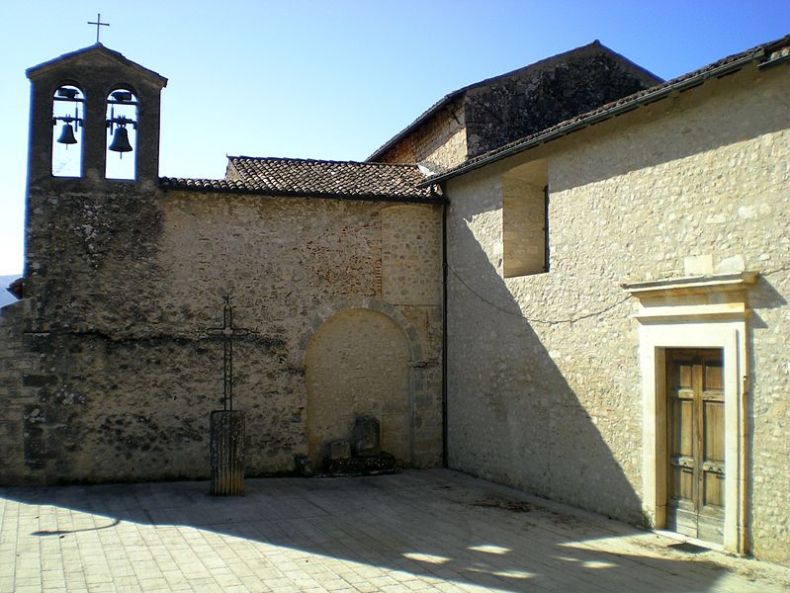
Previously hidden spaces in the 17th-century convent of San Michele Arcangelo (pictured here in 2011) were rediscovered during conservation work after the earthquake. Photo: Wikimedia Commons
Work on buildings in the care of Italy’s cultural heritage ministry (Soprintendenza dei Beni Culturali) follows a different path than private reconstruction projects, which are often speedier, due to a lack of official scrutiny. Major reconstruction of some churches and monuments, and the city walls, is already complete. As for private palaces, many are now refurbished and residents have returned.
Among the success stories is the 15th-century church of Santa Maria del Ponte, considered an architectural jewel, which has had its structure and interior decoration restored. It is reopening to the public this week (25–26 March). Another encouraging story is the recent rediscovery of the hidden spaces of the 17th-century Capuchin convent of San Michele Arcangelo, which had been lost for centuries. They will now be made open to the public.
Work on some of L’Aquila’s key monuments, including the Duomo and Santa Maria Paganica, has been painfully slow to begin. Reconstruction was held up when regional ministry of officials were arrested for corruption in 2014. The delay became a national scandal when vegetation began to grow after the site was left open to the elements for years.
There have been additional disputes over contracts between the city council and Curia, the office of the Archbishop, Monsignor Giuseppe Petrocchi. But now an agreement appears to have been reached and the tender for reconstructing the Duomo is due to be published this month.
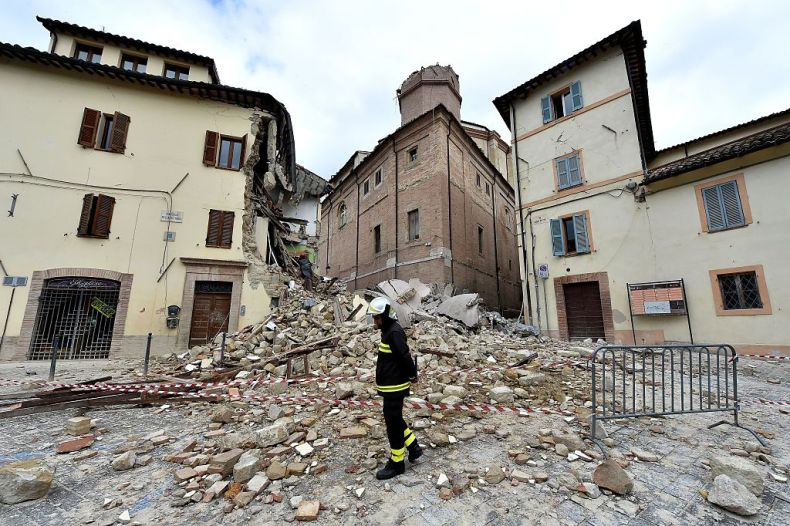
A firefighter stands in front of the collapsed bell tower of the Santa Maria in Via church in the ‘red zone’, an area cordoned off for safety reasons, in Camerino, where 80 per cent of the houses were left uninhabitable after two earthquakes hit the region in October. (28 October, 2016) ALBERTO PIZZOLI/AFP/Getty Images
Smaller municipalities, such as Camerino, a dramatic hilltop town north of L’Aquila in the Marche – where Ciorra teaches at the local university – have also struggled to recover from the more recent quake in October 2016. The hope is that the university can keep the town alive. But even those closely connected to these small communities admit they cannot be saved. This includes villages like Tempera, part of the network of castelli which shaped the landscape around L’Aquila, which was completely razed by the 2009 quake.
Piero Gilento, who hails from Tempera, was a research fellow at the Max Planck Kunsthistorisches Institut in Florence working on the challenges of post-catastrophe L’Aquila. He says the ‘new towns’ have completely de-centred the city and its social system. A great deal of money was misspent and has led to the creation of what he calls ‘non places’ – dormitory neighbourhoods where the economy has virtually collapsed and there are no jobs for young people. Many of these communities are increasingly dominated by the elderly, as the young move out.
Gilento believes that the slow progress of reconstruction is down to the ‘fatal mixture’ of bureaucracy and corruption so widespread in Italy. ‘There is no doubt that at this historic moment the massive sums being made available by the state must be spent in the very best way. The complexity of rebuilding ancient structures must be balanced against the need to give citizens back their own city as fast as possible.’
Architects, citizens and the city authorities are placing their hopes on a new general regulatory plan, to be approved by mid 2017. They believe it offers a crucial chance to redefine the city, its spaces and the relations between the outer areas and the city centre. Gilento, like many others, hopes it will not be another lost opportunity. They want to believe that L’Aquila can be a phoenix rising from the rubble of destruction and the cancer of corruption.
Unlimited access from just $16 every 3 months
Subscribe to get unlimited and exclusive access to the top art stories, interviews and exhibition reviews.

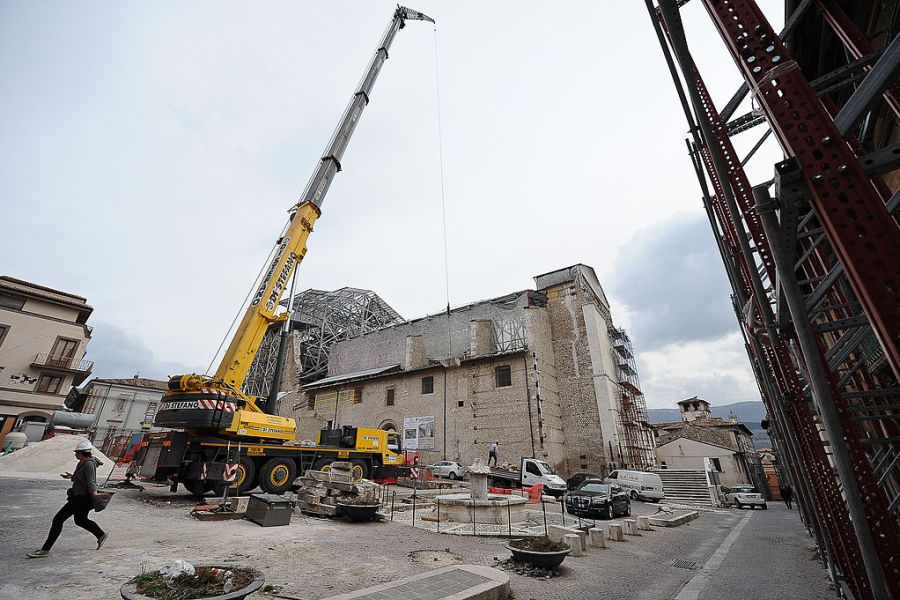
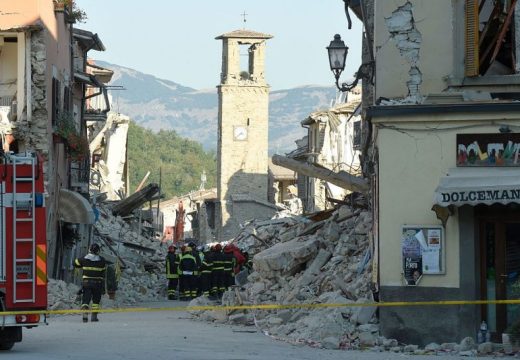

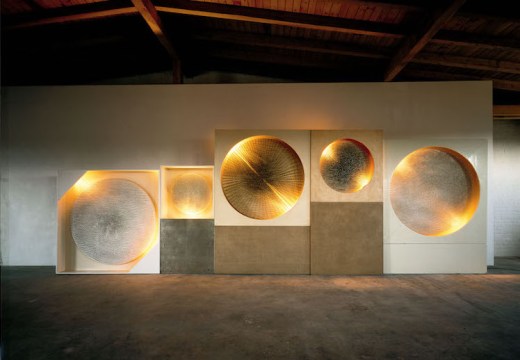









![Masterpiece [Re]discovery 2022. Photo: Ben Fisher Photography, courtesy of Masterpiece London](http://www.apollo-magazine.com/wp-content/uploads/2022/07/MPL2022_4263.jpg)
It’s time for the government of London to return to its rightful home